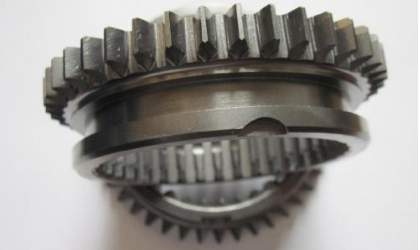| [Visitor (112.0.*.*)]answers [Chinese ] | Time :2022-06-26 |  The gear to be meshed smoothly through the synchronizer achieves a consistent speed and smooth meshing, and the common structure of the synchronizer is in the form of tooth sleeves, slides, and copper rings. The gear to be meshed smoothly through the synchronizer achieves a consistent speed and smooth meshing, and the common structure of the synchronizer is in the form of tooth sleeves, slides, and copper rings.
The shift of the old transmission should adopt the "two-legged clutch" method, the upshift stays in the neutral position for a moment (but the clutch needs to be lifted, the purpose is to make the clutch piece also synchronize with the flywheel, the speed must be consistent to hang the gear smoothly, if the gear shift is slow, the speed falls to idle, it is also impossible to hang in), the gear reduction should be in the neutral position (while keeping the clutch raised) Throttle to reduce the speed difference of the gear. However, this operation is more complicated and difficult to master precisely. So the designers created the synchronizer. |
| [Visitor (112.0.*.*)]answers [Chinese ] | Time :2022-06-26 |  2 The main functions of the actuator 2 The main functions of the actuator
The selection of double-acting actuators takes the DA series pneumatic actuators as an example. The output torque of the gear strip actuator is obtained by multiplying the piston pressure (supplied by the air supply pressure) by the radius of the upper joint circle (force arm), as shown in Figure 4. And the friction resistance is small and the efficiency is high. As shown in Figure 5, the output torque is linear when rotated clockwise and counterclockwise. Under normal operating conditions, the recommended safety factor for dual-actuators is 25-50%
Collapse edit this paragraph for a single purpose
The selection of single-acting actuator takes the SR series pneumatic actuator as an example In the application of spring reset, the output torque is obtained during two different operations, and according to the stroke position, each operation produces two different torque values.The output torque of the spring reset actuator is obtained by multiplying the force (air pressure or spring force) by the force arm: the output torque is obtained after the air pressure enters the cavity compression spring, called the "air stroke output torque" In this case, the air source pressure forces the piston from 0 degrees to 90 degrees, due to the reaction force generated by the spring compression, the torque gradually decreases from the maximum value at the starting point until it reaches the second situation: The output torque is obtained by the spring recovery force acting on the piston when the middle cavity is out of gas, called " Spring Stroke Output Torque" In this case, due to the elongation of the spring, the output torque gradually decreases from 90 degrees to 0 degrees as described above,Single-acting actuators are designed based on the resulting equilibrium moment under two conditions, |
|

